Flash Sales Guide: 17 Proven Ideas & Amazing Examples



Flash sales topped $9.3 billion in 2023—a 7.5% increase from 2022.
Known as the “golden hours of retail,” people take advantage of flash sales because of FOMO on last-minute deals.
This format is picking up.
Unfortunately, many businesses think they’re only about purging old stock and offering some familiar discounts.
At Convertcart, we’ve worked with 500+ US businesses, helping them maximize conversion optimization efforts, including flash sales.
In this piece, we’ll focus on 14 proven ways we’ve repeatedly seen make flash sales a success, some brilliant examples, and best practices.
But first:
Let’s kick it off with 👇

Why this flash sale campaign works: It weaves in the sale along with a brand highlight—the founder’s birthday.
So whether loyal customers access it or new ones do, it’s a way for the brand to build a deeper connection.
Takeaway: A flash sale can be the means to an end—greater brand awareness in the long term.
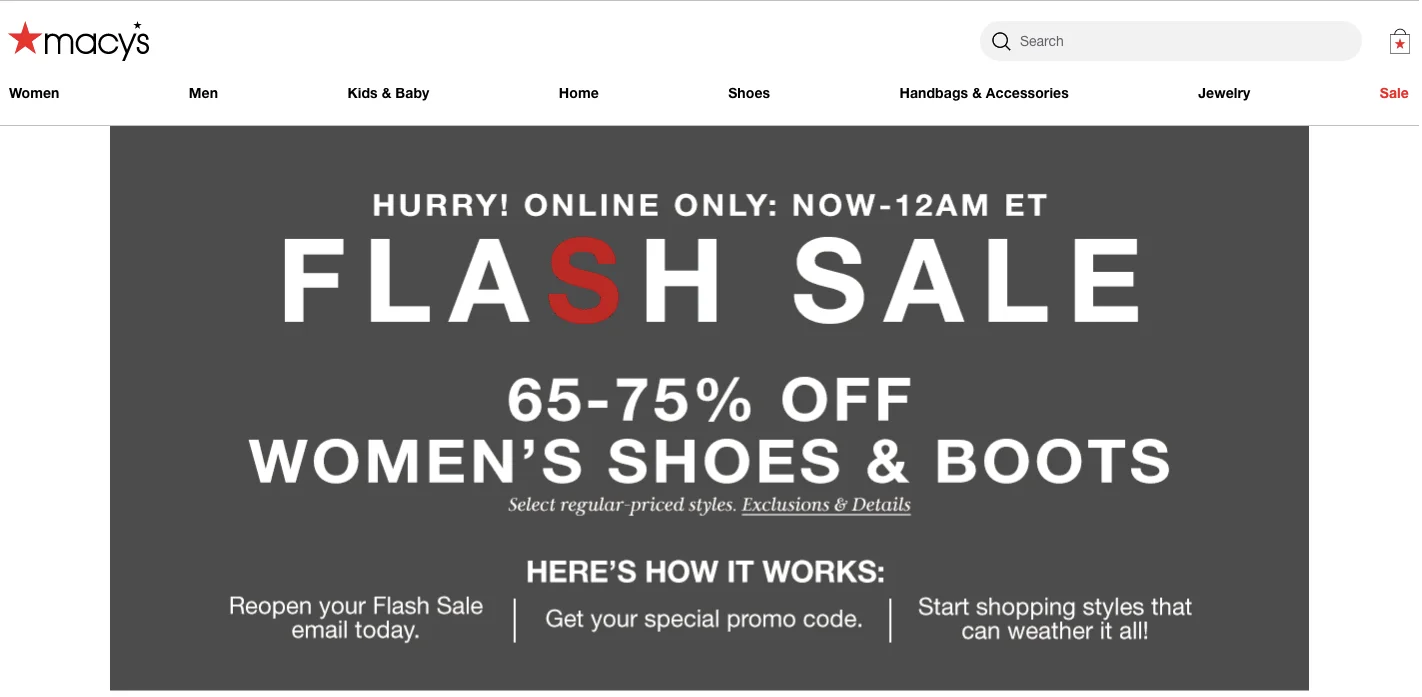
Why flash sale campaign works: The layout is simple, which makes space for all the important information.
Additionally, it nudges shoppers to engage with the flash sale emails that have been sent to them.
In a nuanced way, the brand is making shoppers open their emails and acclimatizing them to communication from their side.
Takeaway: Use a flash sale to re-engage customers with brand emails—it will likely make them open your emails in the future too!

Why this flash sale example works: No one minds paying only half the price of any product.
And the fact that the brand brings attention to “hundreds of styles” also makes for an effective hook.
Takeaway: Figure out what your audience’s prime motivation is (in the above example, to experience more choices around fashion) and then use it as a hook in your flash sale creative.
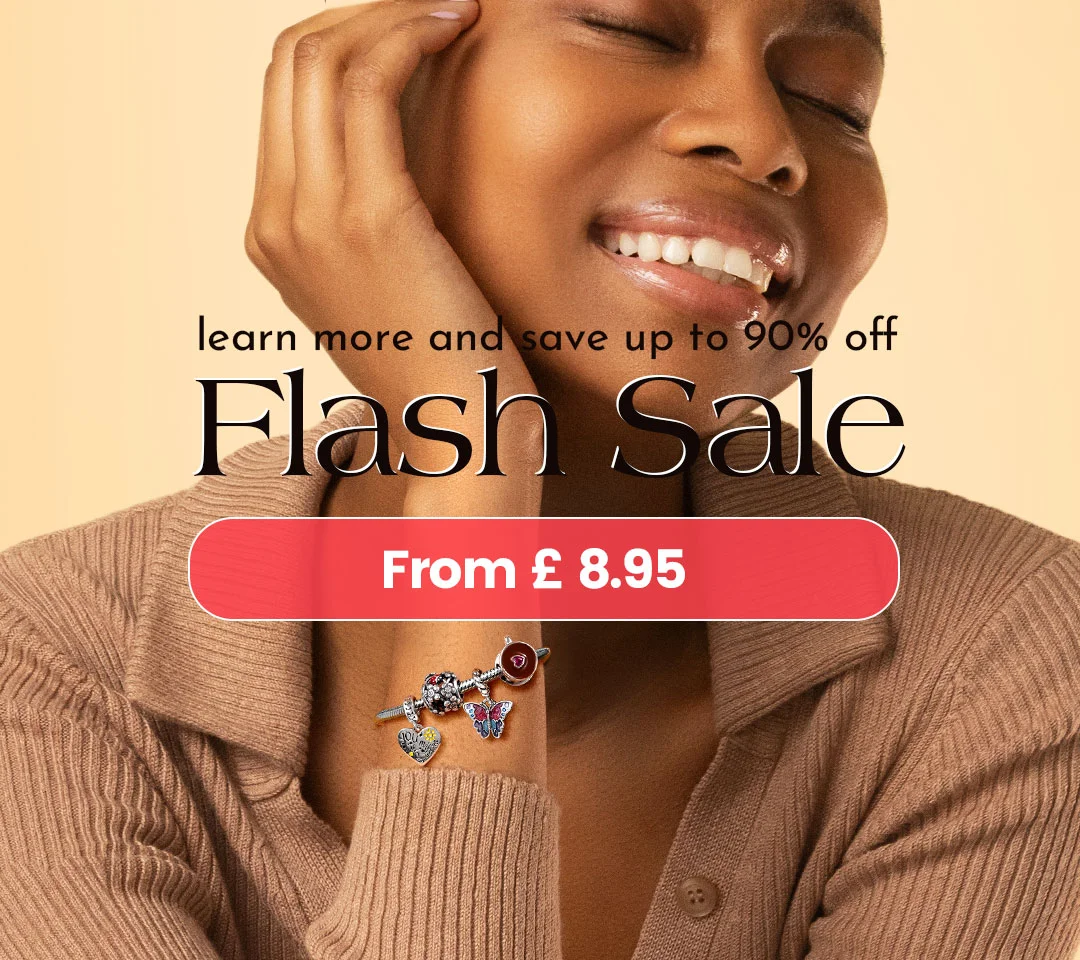
Why this flash sale example works: It’s a bold, creative that keeps the words and imagery super simple, but packs a functional punch with the CTA that cites the lowest price shoppers will be able to enjoy if they went shopping at the sale.
Takeaway: Leverage the CTA to increase the motivation to buy (if you can highlight benefits like the lowest price, then nothing like it).
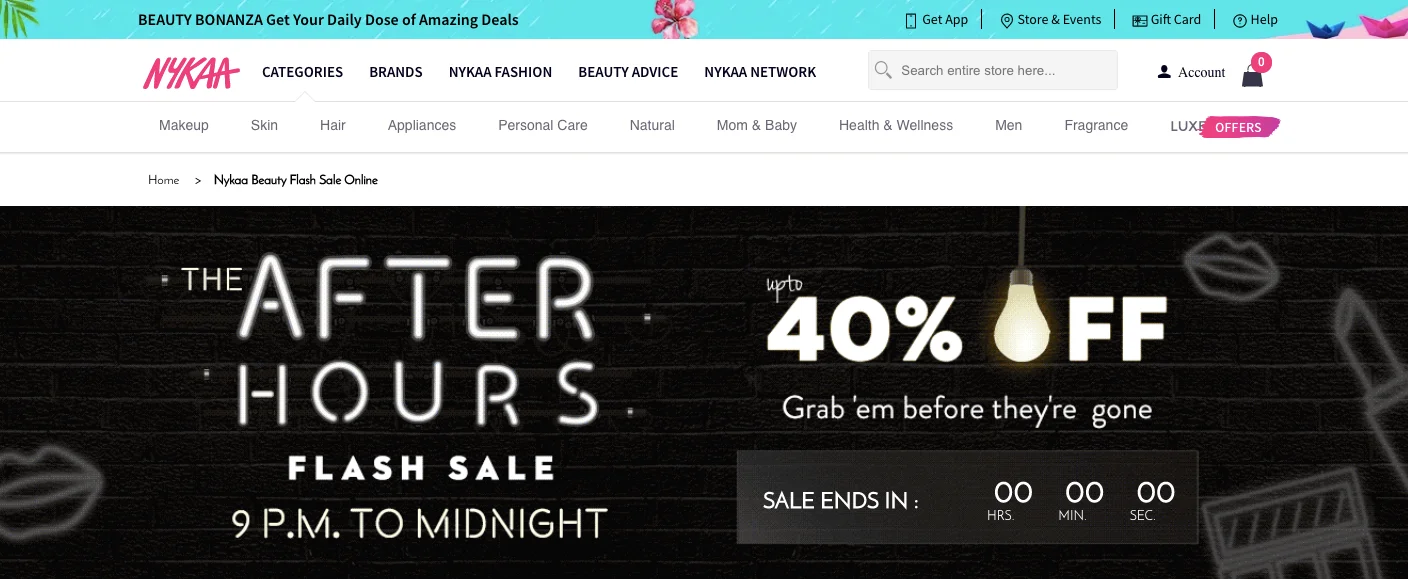
Why this flash sale campaign works: The super limited, specific-time flash banner example. Meant to attract those who are seriously looking for a good deal – the after-hours timing gives an edge, because shoppers are not encumbered with work, social interactions, or other preoccupations and can fully focus on shopping.
Takeaway: Make the most of the hours you’ve seen your audiences buy from you—for example, if it has been in the afternoon, consider holding a multi-hour flash sale within that window.
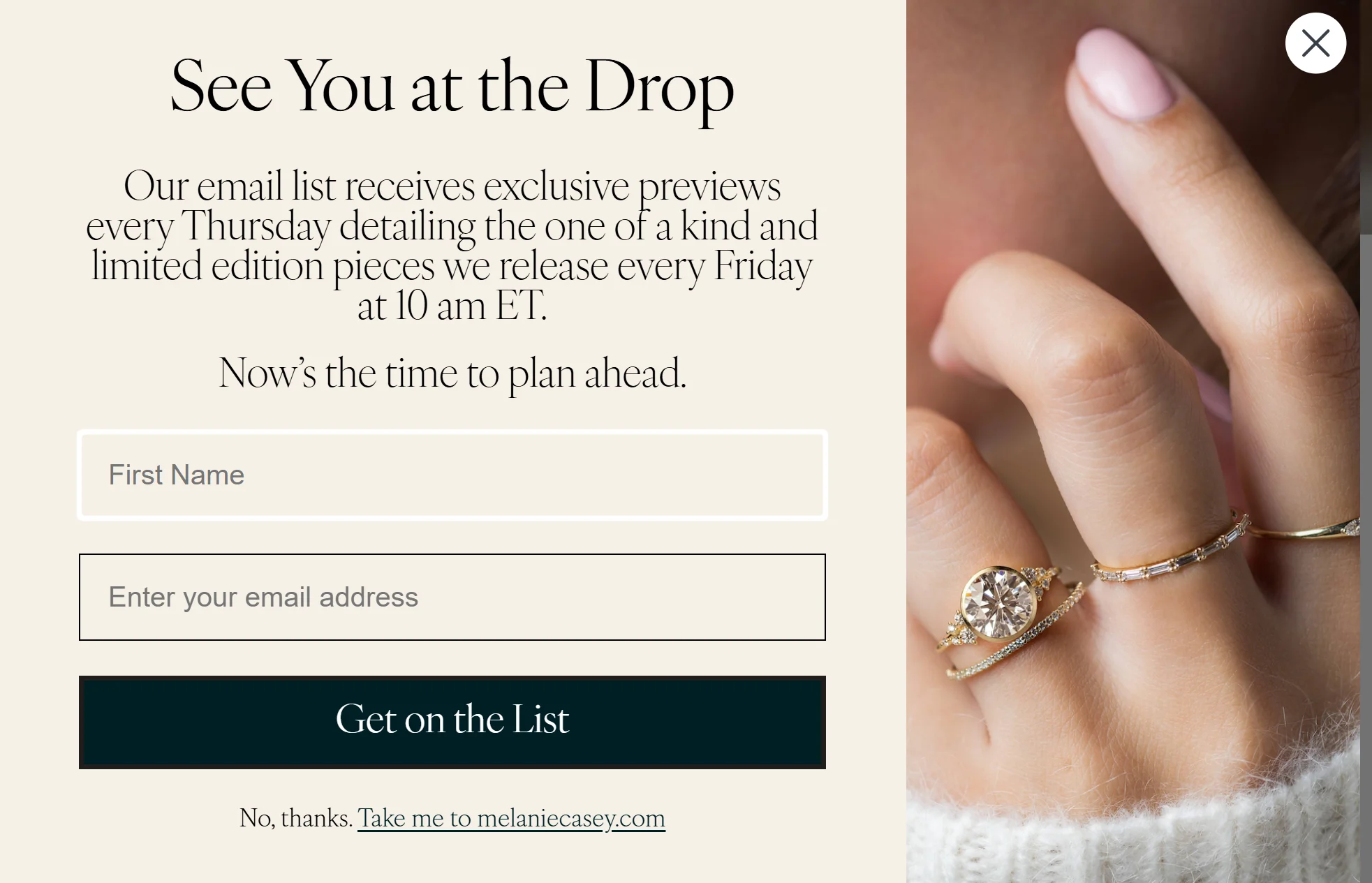
Why this flash sale campaign works: Uses a pop-up to tease early access for the limited edition product drops that Melanie Casey launches every Friday (which creates a kind of recurring Flash Sale Friday).
Takeaway: All flash sales don’t have to be based on discounts – they can work on repeatable themes like limited-time product drops, or 24-hour archive sales.
1. Craft your flash sale strategy according to your goal
2. Consider optimal timings during the year to run flash sales
3. Offer a flash sale on products you HAVE competition for
4. Promote products with otherwise low conversions
5. Price your products just right
6. Combine a product drop + flash sale
7. Get your communication right
8. Build urgency in unusual ways
9. Consider an always-live flash sale section on your website
10. Introduce onsite pop-ups for the flash sale
11. Write flash sale emails that can boost conversions
12. Let’s talk social media promotions
13. Inventory management and fulfillment
14. Use a mini flash sale format to gather learnings
15. Improve your customer support during flash sales
16. Narrow your target market for higher ROI
What products you’ll be bringing on the line for the sale, what window you’ll set for it, and how much discount you’ll offer will depend on one thing: the primary goal behind the flash sale.
For example, if your motivation is to reignite interest in an existing line of products (which has ample competition), the strategy would need to differ from a flash sale you’d announce on a new line of products.
Here are some questions you may want to ask to assess the primary goal:
Bringing low-converting products to the flash sale mix is one of the ways to stabilize your product inventory, for example.
Promoting products that are already well-loved by existing customers—considering how important social proof is for online purchases—may be a good idea.
Announce a flash sale but run it in a gated way—where you lay down certain terms and conditions for existing customers to qualify for it, or better still, send out personalized communication to this segmented group.
Announce a tiered flash sale, where buying more products would automatically mean a larger discount, and this would also meet your ongoing goal of increasing AOV.
If you consult any eCommerce specialist, they'll tell you there's no universally optimal time for scheduling a flash sale. The timing largely depends on the nature of your products and the purchasing habits of your customers.
Analyzing past order data can help you make an informed decision on the best timing for a flash sale that suits your online store. Check:
However, if you're new to this, here are some recommended times to consider for running a flash sale:
Run your flash sale way before the holiday season—as early as October.
Why?
Because the holiday season means—online shoppers will get bombarded with marketing emails—which can cause flash sale fatigue. This will give you the opportunity to win over new customers, get ahead of the competition, and also make room for new inventory.
Once the holidays are over, you may see a spike in order returns. That’s because customers are returning unwanted gifts, but that doesn’t mean you have to lose out on money. By offering a flash sale after the holiday season (in January), then you have an opportunity to make up for the loss in returns, as well as build customer loyalty.
Consistently running a flash sale can tarnish your brand’s reputation—it’s better to run a sale every few months. You can even tie your sale into a holiday, such as Father’s /Mother’s Day, Valentine’s Day, and Fourth of July, when online shoppers are oftentimes looking for deals.
Pro tip: Studies show that 50% of flash sale orders occur within the first hour. Most flash sales last anywhere between a few hours to 36 hours.
Identify products that your direct and indirect competitors are creating.
- Start by conducting thorough market research to understand which products in your inventory face significant competition
- Use tools like Google Trends, Amazon Best Sellers, and industry reports to identify popular products within your niche
- Look for items that frequently appear in top searches and best-seller lists, indicating high demand and competition
Once you have a list of potentially competitive products, analyze your competitors' offerings.
- Visit the websites of your competitors
- Check their pricing
- Read customer reviews
- Observe their promotional strategies.
- Examine your own sales data to identify products that consistently perform well and have a higher sales volume.
- Cross-reference these with competitor analysis to see if these popular items are also offered by other brands.
- Additionally, customer feedback and inquiries can provide insights into which items are frequently compared to competitors' products.
Create a flash sale around a range of the shortlisted products from the above steps and limit it to these, like in the following example that clearly mentions the products the flash sale discount applies to:
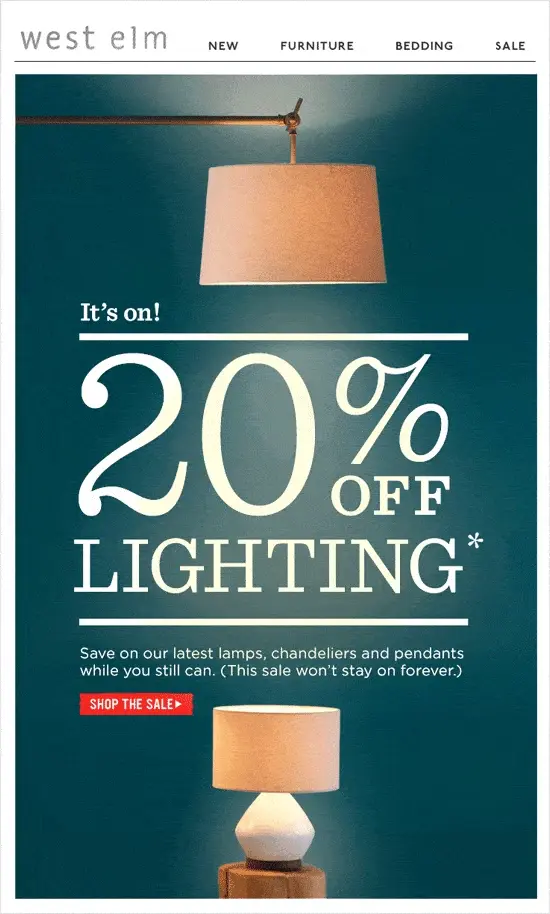
Read eCommerce site search: 18 improvements that prevent drop-offs (+ actual examples)
Another approach based on your goal could be to discount low-conversion products.
Low conversions aren’t all that uncommon in eCommerce––and a well-thought-out flash sale could be the perfect opportunity to push products that haven’t been converting.
Practically, the reasons behind low conversions could be several – right from poor navigation to unspecific product information––but fixing them one by one can be time-consuming.
In a flash sale context, you can choose to take a different approach by creating very specific landing pages for these products (especially if you’re segmenting your audience and the categories they’d prefer seeing).
Here are a few ways you could consider:
Whether you’re promoting an additional discount or attempting to attract shoppers through free shipping, the main benefit needs to come out.

If it’s dynamic, it’s even better—let’s say a shopper hangs around for 20 seconds, during which the ticker states a changing number to indicate more numbers of the product being sold.
Ensure not to feature any other promotions or daily deals on these landing pages.
While the products you promote through it could be commonplace, the spin you give to why the sale is on could entice people to shop.
Check this example from J. Crew—the spin they’ve given to this is that of summer being a happy event, and their target audience wanting to make the most of it.
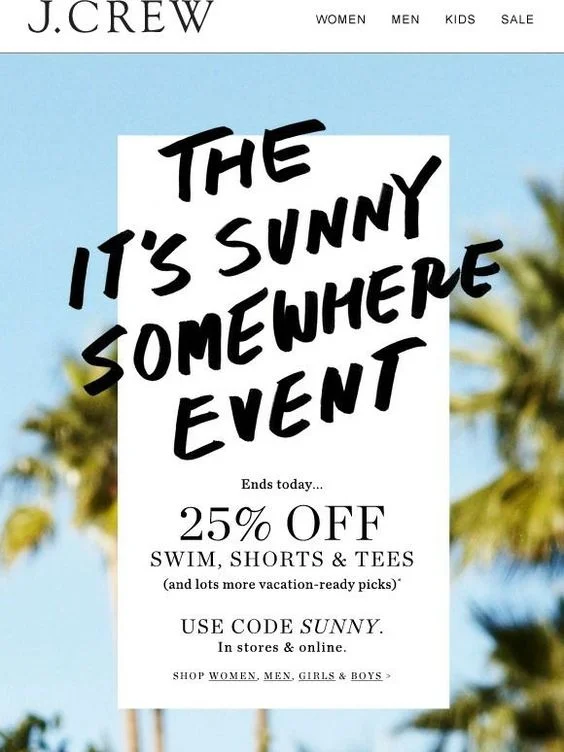
Because let’s admit it:
Even the most interested shopper will consider buying from you only if they think it’s a deal other places won’t offer, and if there’s something special about it.
Consider the following example—the discount offered is a steep 80% and instead of offering it on everything, it’s applied on “select styles only”—so even if you’re promoting low-converting products, they can be positioned as “select.”

Your pricing needs to be super strategic. On one hand, it should attract customers, and on the other hand, it should not cut into your profits.
Let's find that balance in the steps below:
First, it’s crucial to have a clear understanding of all your costs, including the cost of goods sold (COGS), shipping, packaging, and any additional fees such as transaction or marketing costs.
Calculate your break-even point to ensure you know the minimum price at which you can sell the products without incurring a loss.
Conduct thorough market research to understand how your competitors price their products during flash sales. This will give you a benchmark and help you remain competitive.
Also, consider the expectations of your target audience—what discount percentage would likely motivate them to make a purchase? Once you have this data, select appropriate discount levels that balance attracting customers and maintaining profitability.
Common flash sale discounts range from 20% to 50%, but this can vary depending on your industry and goals. Test different discount levels in smaller campaigns to find the sweet spot that maximizes both sales and profit margins.
The flash sale context comes in handy when you’re considering a product drop.
By leveraging the limited-time launch scenario, you can even test out the product’s significance and if it can create competition for other brands in the same eCommerce space.
When you add a flash sale to a product drop context, it just offers an additional incentive to buy into the urgency created by the product drop.
Here are a few implementable flash sale ideas:
Channels like WhatsApp, push notifications, and SMS have better open rates and are more likely to be accessed & opened by your loyal customers.
(Research, for example, says that push notifications increase the open rate by almost 56%.)
This way, you can even track which products are being included more from the drop.
Here’s an example of how you can layer the discounts against the associated spend in your flash sale creative:

This can especially be attractive for existing customers because by offering early access, you’re giving them more room to make a purchase choice.
Call this feature out on your flash sale creative: “VIP Early Preview” and “Early Access Just For You” work well.
Here’s an example from Paperless Post:
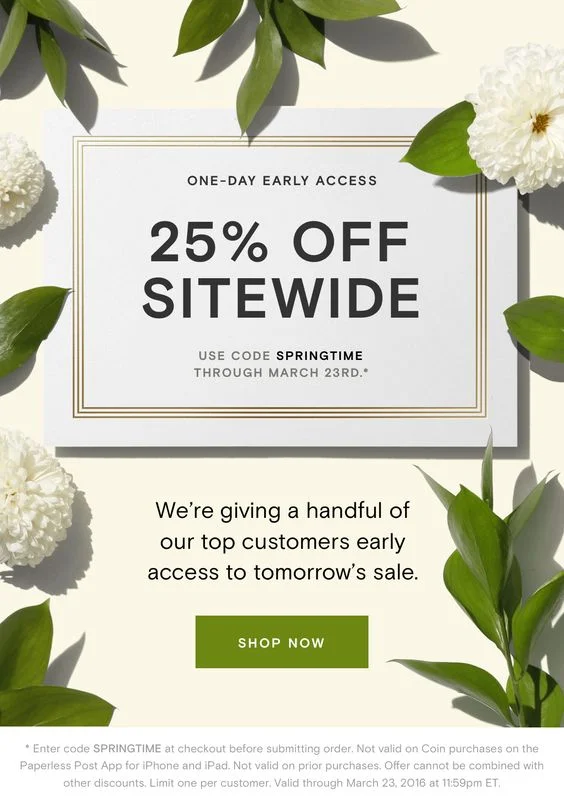
Can't get conversions off your mind? Read: Why is your conversion rate dropping: 24 possible causes
Remember: Since discounts are everywhere in eCommerce these days, to make your flash sale count, you’ll have to be precise about getting your communication right.
Here are a few actionable tips:
We’ve said this before: Just highlighting a discount might not be good enough for your target audience.
For example, if you’re in a category where free shipping thresholds usually apply, a flash sale could be the right opportunity to extend free shipping––have your promotions and all communication material carry this as the USP.
In the following example, the brand is clearly running the flash sale on 3 of their most popular diffusers––this becomes the USP or the differentiator and would need to come across clearly in the communication, across channels.

How you position the flash sale promotion (according to the category you cater to) is crucial.
What works for a fashion brand may not work for a healthcare brand. For example, even if your intent behind the flash sale could well be clearing out inventory, as a fashion-based eCommerce store, you can call it a “clearance flash sale”.
But if you say the same thing as a health-based supplement store, it’ll most likely have people turning away.
(However, something like “the bulk up sale” might get shoppers interested in nutrition and building up their bodies to instantly take notice.)
In the following example, return customers are clearly being targeted through the “customer appreciation” call-out.
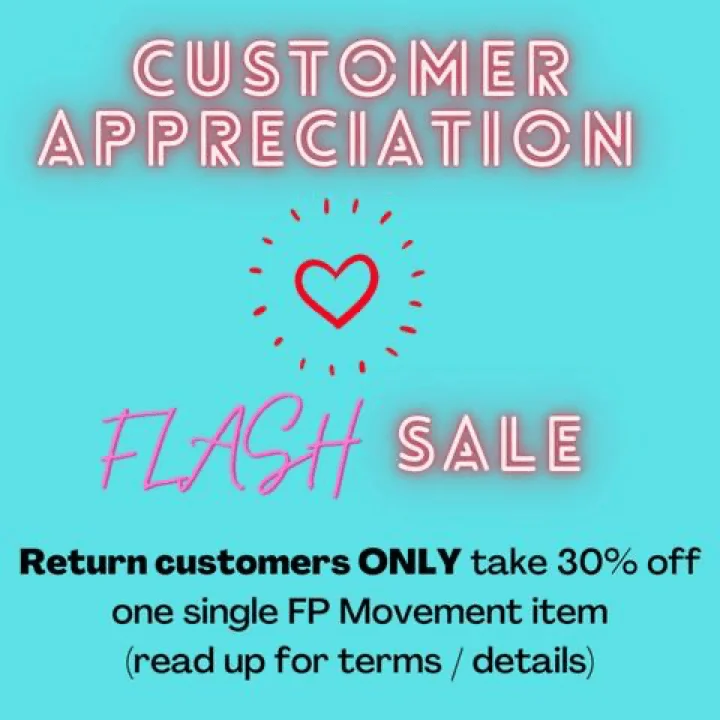
The point of any flash sale is to get as many buys as possible within a short window of time (anywhere from a few hours to a few days).
This means your regular “shop now” or “buy now” may not convey as much relevance—partly because shoppers are used to seeing them everywhere, every day and won’t subconsciously take notice if you associate them with a flash sale.
If you can create emotions like curiosity or a sense of “too good to be true” through your CTA, it can convince shoppers to turn their attention to the sale at that moment.
Catchy CTAs can read like: “Don’t miss out”, “Shop till you drop”, “Make it happen,” and “Hurry! Shop Now!”
The following CTA example from Levi’s captures what we’re talking about.
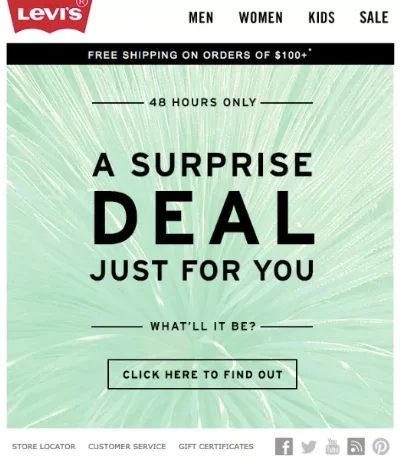
Countdown timers and words like “hurry” aren’t the only ways to do flash sale communication (on-site and over email).
Here are a few unusual ways in which you can create urgency in your flash sale:
Phrases like “In high demand” and “selling super fast” can come in handy.
A short section saying “selling fast” and carrying some crucial numbers could also create urgency. Also, ensure you only show sizes that are in stock (don’t lead shoppers to out-of-stock variants during a flash sale).
This invariably attracts the maximum eyeballs, given how many potential customers land on your homepage first.
Highlight the duration of the sale, the discount % , and any applicable flash sale promo code clearly.
This is a way to keep shoppers on their toes—especially those who add items to the cart, and then plan to come back later for the actual purchase.
This will make it easy for you to say that the more they buy a specific product, the more discount they can avail.
Consider offering a coupon code under such circumstances.
Consider announcing targeted birthday flash sales—for example, segment customers who have their birthday in June, and build urgency around that.
This works especially well for new product launches and fresh releases where products are let out with updates.
Here's a read to make you think: 30 Best Examples of Nudge Marketing in eCommerce
While flash sales of the exclusive and limited-time kind work the best, there’s still another way to leverage this format.
Consider putting up an always-live flash sale section on your website.
Send out communication updates so that shoppers get to know.
Segment communication based on what categories and products have been preferred by customers in the past.
This can help highlight the flash sale section more.
That way you won’t just have shoppers who already know about this, but also new customers who’re exploring the site.
Let’s say, a customer who is looking for a flash sale in the category you operate in will be shown this section as a result.
eCommerce brand Shein, for example, has such a section permanently logged against “SALE” under the primary navigation.

Unsuspecting visitors usually don’t have a clue about limited-duration sales going on on your eCommerce site.
This makes it crucial for you to introduce on-site pop-ups that can communicate details about the flash sale.
Here’s what you can include so that the pop-up stands out:
If it can be done in just a few steps, including a one-page checkout, your customers need to know that.
By offering them an additional discount, you can even ask for their email address. Or you can do it like Nine West does during their end-of-season flash sale, by promising an extra 30% off at checkout:
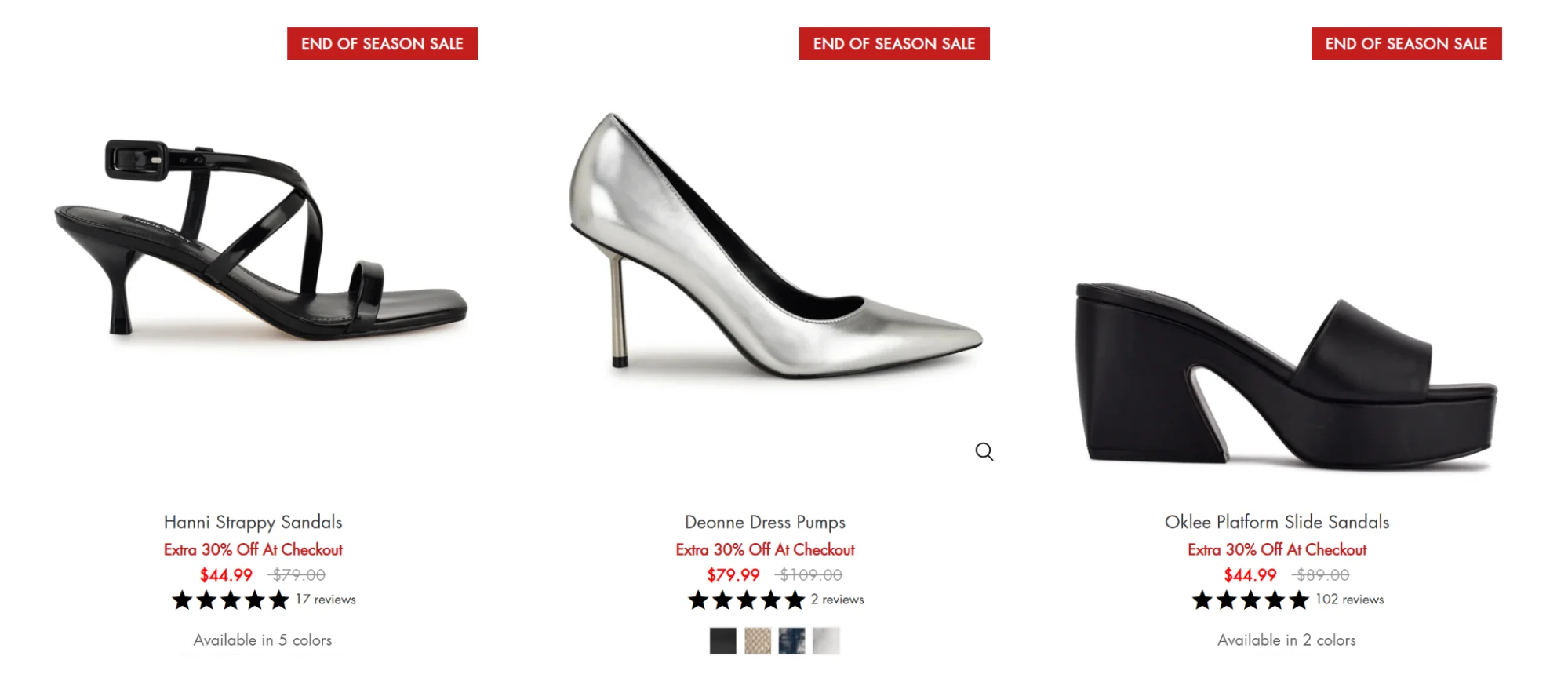
If you can catch your audience's attention by bringing exclusivity and scarcity together, then the chances are higher that they will act.
Here's an example.

In the example we picked, the headline works because it essentially creates a sense of regret and “this is too good to pass”.

Simpler flash sale announcement headlines can read like:
“Last Call”
“It’s Now or Never”
“Squeeze the Day”
“Cancel your plans.”
“Drop everything & shop!”
Get more perspectives through Exit-Intent Pop-Ups: overcoming common mistakes + 20 brilliant examples
If you want your flash sale to work well, you’ll have to strategize the email campaign that will accompany it.
Here’s an email sequence you may want to use for your next eCommerce flash sale:
- Launch announcement (three days prior to the launch)
- A day prior to the launch
- A day before the sale ends
- Information about any possible date extensions
Since you’ll most likely have to segment your customers clearly to make the most of the flash sale, ensure your communication is on point.
Ensure you highlight your flash sale USP alongside the discount and timeframe.
Here’s an example from Bath & Body Works that captures the fact that the flash sale applies to full-sized body care products only.

Additionally, you can include social proof about what existing customers have had to say about previously announced flash sales––highlighting what they’ve liked and how good the deal was.
You could also consider introducing a short quiz to learn about their preferences––clearly indicate that a few short questions will help you come up with better recommendations and the best deals.
Look at ways of personalizing the main message: “Just for you”, “Extra 15% off only for you”, “Surprise inside” etc. can work well depending on what you’re trying to promote.
Consider bringing in product recommendations in your flash sale email.
This can especially be effective if they’ve been searching for or known to prefer the same or similar products (based on purchase & add-to-cart behavior, email opening behavior etc.)
Here’s an example from Avon.
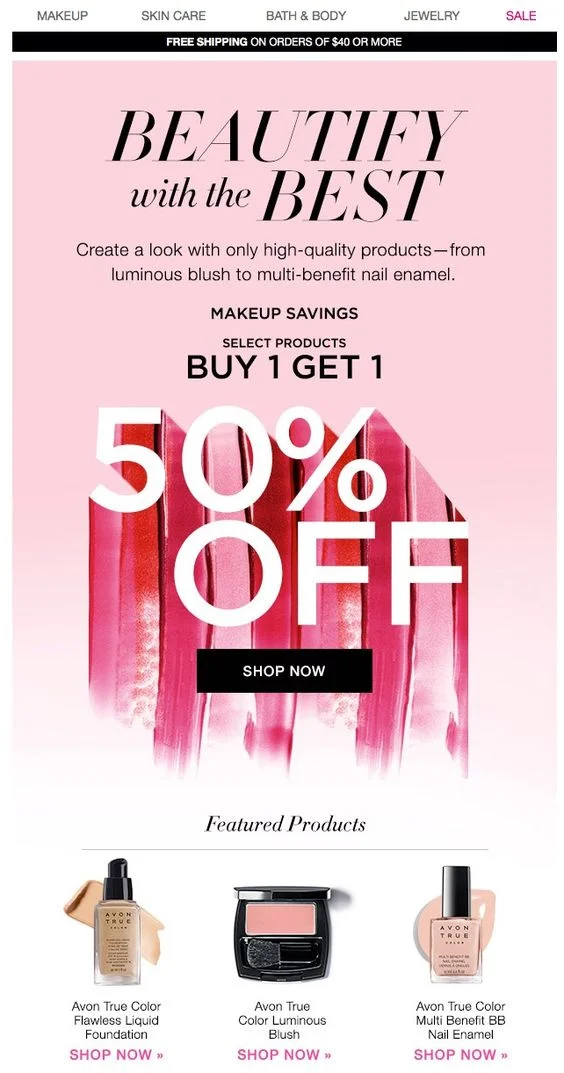
Highlight products they’ve somewhat engaged with, in the past––they may have checked these products out and spent some time viewing the product pages or even added them to cart without actually checking out.
Create email reminders that give them an idea of how much they can potentially save from the flash sale, as against if they missed it.
Remember, shoppers are in a hurry most of the time, so if you do a little math for them, they’re more likely to take action.
In the following example, notice how, through price anchoring Adore Me establishes the extent of savings as well.
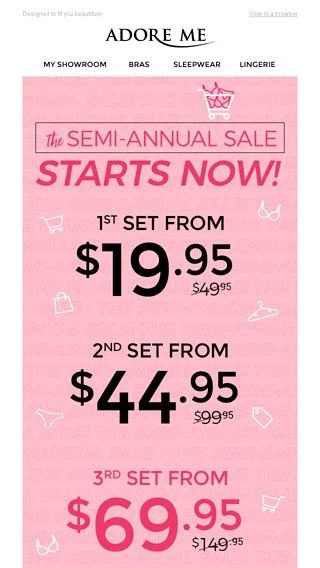
Offer something VIP or exclusive to take their interest at least a few notches up—if it’s for a very specific line of products, ensure you’ve done your customer segmentation precisely.
Here’s an example:
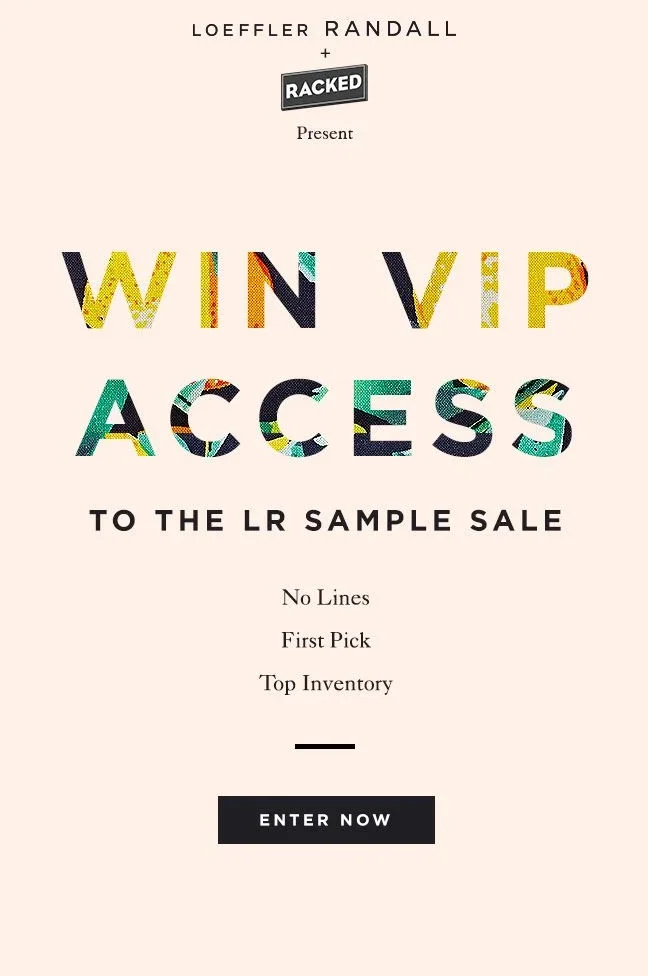
Consider nurturing them through a series of emails, but ensure to not bombard them all that much—they might be not engaging with your brand as a matter of choice, and might just get put off if you send them several email updates.
Engage with them over a failover channel like a chat app or push notification (because the primary channel of communication may have changed).
Can't stop thinking of customer retention? Read 17 retention strategies that actually work (for eCommerce)
Successful flash sale marketing boils down to the following formula: Great merchandise + deep discount + limited-time.
And this should be your promotion messaging.
In addition to email marketing, utilize your social media channels to build hype around the flash sale. Create a countdown campaign on platforms like Instagram, Facebook, and Twitter, posting regular updates to keep your audience engaged and excited.
Paid social media ads can also be highly effective; target these ads to your existing customers and lookalike audiences to reach potential new buyers.
Lastly, consider partnering with influencers or brand ambassadors who can promote your flash sale to their followers, expanding your reach and adding credibility to your promotion.
Let’s just agree that all the planning and execution is ultimately for shipping products to the customers—so, this is a “must get this right”.
Begin by analyzing past sales data to predict demand accurately. This helps in stocking the right amount of inventory and avoiding both overstocking and stockouts.
Utilize inventory management software that offers real-time tracking and automated alerts when stock levels are low. It's also essential to coordinate closely with your suppliers to ensure that you can quickly replenish popular items if necessary.
Ensure your warehouse staff is well-prepared for the increased volume by scheduling additional shifts or temporary workers if needed.
Streamline your packing and shipping processes to speed up order fulfillment; this could involve pre-packing popular items or using batch processing for orders.
Partnering with reliable shipping carriers is also crucial to maintain fast and accurate delivery.
This is especially helpful if you have your eyes set on a multi-day window for your next flash sale.
But what’s the guarantee it’ll work just because you’re doing it, let’s say, around the peak holiday season?
One way we’ve seen businesses gather a firmer foothold in materializing a multi-day flash sale is by running a multi-hour one first.
You can gather real-time evidence from this exercise.
You’ll get an understanding of which products are making it successfully to checkout, and for those shoppers who aren’t buying anything—if there are repeated searches on products/categories that the sale does not cover.
For example, if you’re a beauty brand and you find more shoppers focusing on makeup instead of skincare, take that as a pattern.
For better assessment, consider the context in which you ran the flash sale––for example, it was right before the holiday season, and more shoppers reaching out for a great makeup deal makes complete sense.
Do read: Beauty Brand Email Marketing: 30 Great Examples (+Templates)
This could mean you may have thrown up close recommendations, but shoppers may not have found them important enough to add-to-cart.
This can offer you deeper learning on what to include in your next flash sale and which products to additionally include based on terms that were searched (especially if your categories don’t offer close matches in terms of products).
This would include the window you chose for the sale to last—be it multi-hour or multi-day.
Also, assess if the time of day worked – if it worked, then it must have aligned with the living/working habits of your target audience, and if it didn’t, you may have changes to make for your next flash sale.
Not everyone who arrives at your store during a flash sale will know the full layout of your eCommerce store. So, when running flash sales on your eCommerce site, expect questions about:
- stock availability
- coupon codes
- shipping times
- return policies
So, in order to successfully improve your flash sale optimization, try:
Extend support hours to cover the timing of your flash sale, especially if you’re running hourly or weekend flash sale events.
Set up AI chatbots or automated responses for FAQs like “Is this flash sale deal still valid?” or “When will my order ship?”
Use SMS or WhatsApp to retarget cart and browse abandoners during your flash sale window.
Add microcopy on your flash sale UI – FAQs, timers, or banners – this way, customers won’t feel the need to reach out in the first place. Here’s a great example from BooHoo:
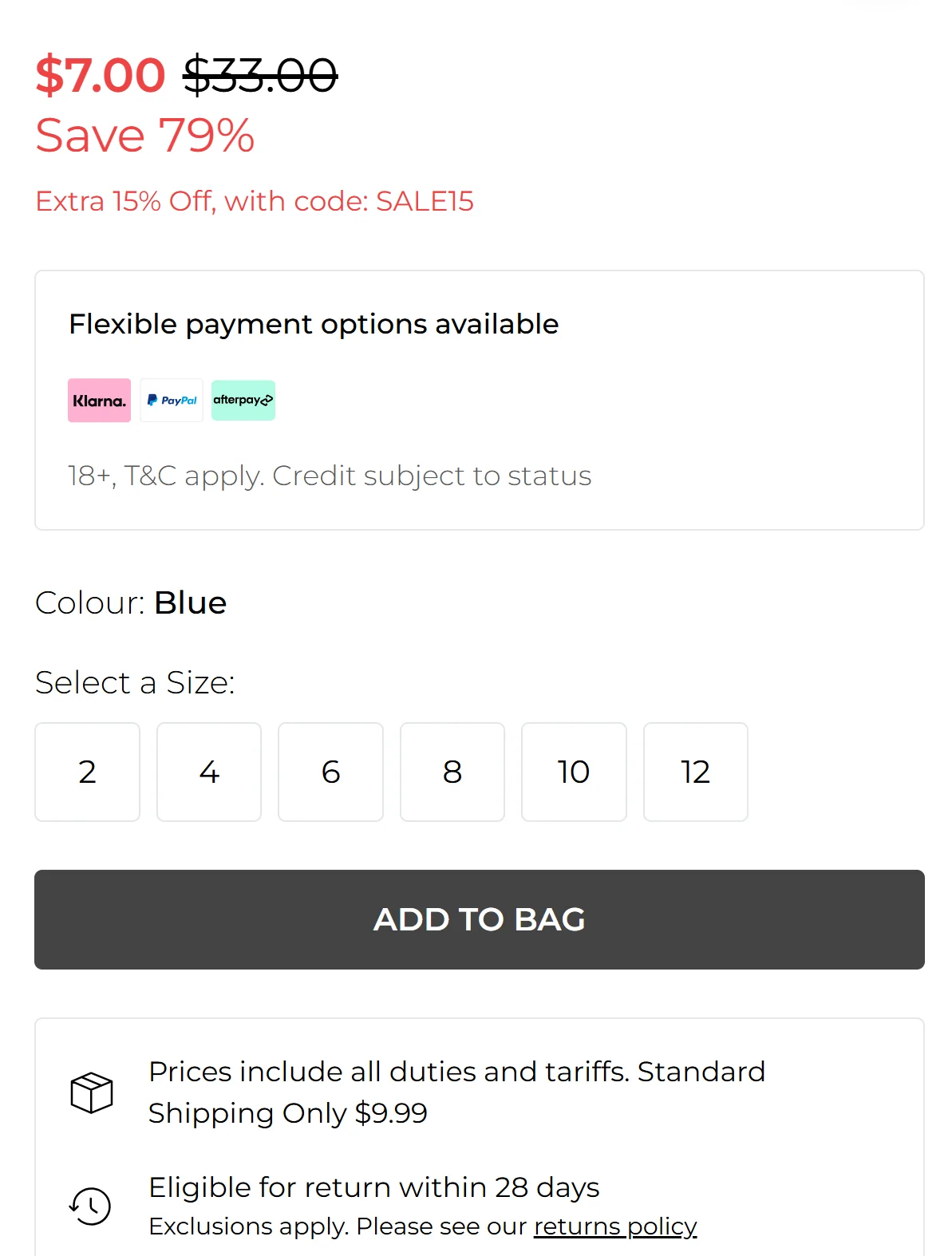
You don’t need to open your entire eCommerce site to a flash sale. At least, not always. You can narrow down your target audience by:
It’s a well-known fact that nearly 70% of all carts go abandoned. So, a flash sale, a secret one in particular, one with exclusive discount codes and free shipping, can motivate those on the edge to convert. Note how Freddie does this, in their flash sale ad, by leading to a separate pre-sell page:
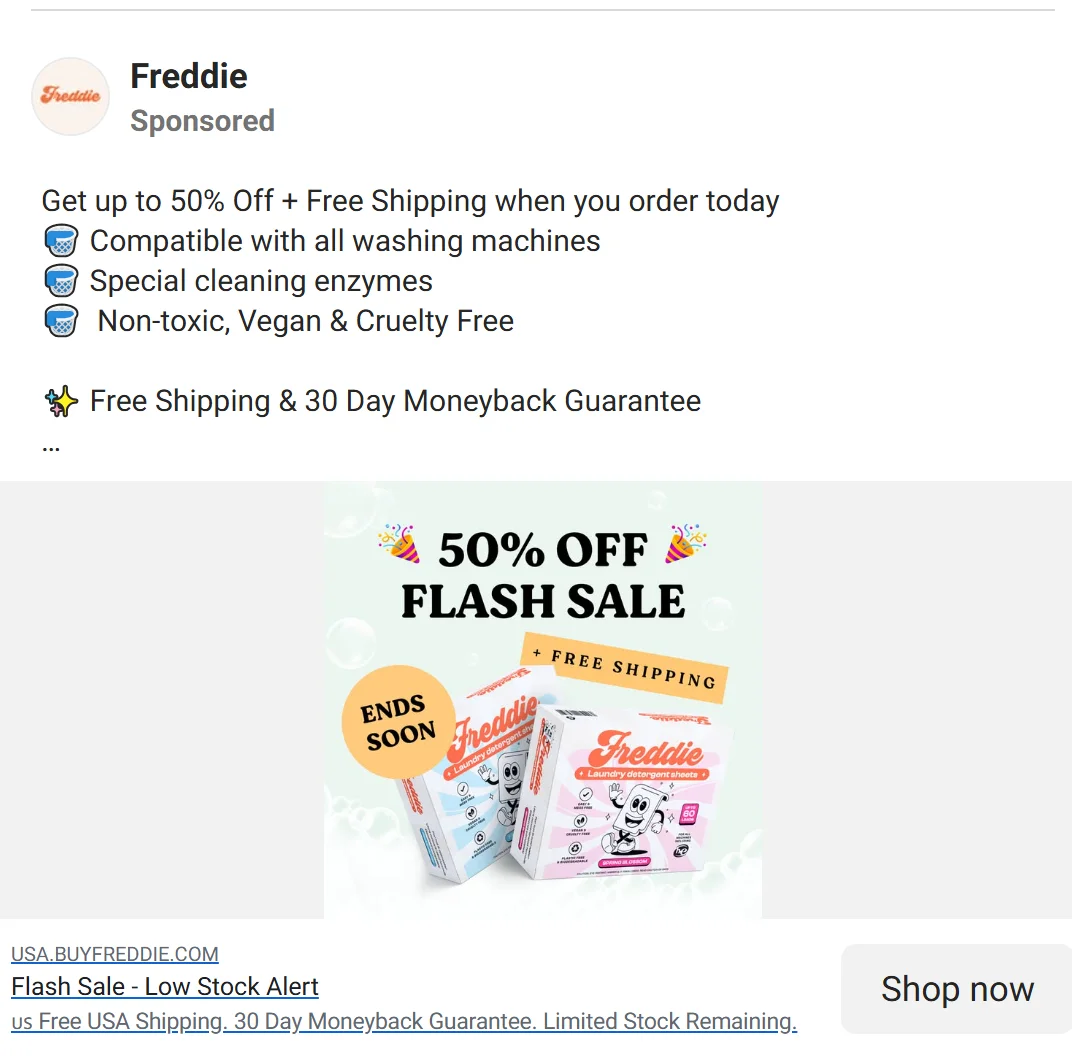
This way, you target two birds with one flash sale – just ensure you filter down the recommendations in your emails and SMS(s) to match past browsing history. For example, if a shopper who bought a product variant never bought again, offer a similar product at discount in your flash sale messaging.
Let’s say you’re running a flash sale on dress shirts. Send specially curated emails based on past purchases to effectively cross-sell. For example, if someone bought pants, curate recommendations to their exact purchase – like color, size, style match, etc.
Pro Tip: Exclude recent purchasers of a particular product category you’re putting on discount. Or else, you might end up losing loyal shoppers.
Manual execution can break a flash sale strategy. Instead, automate as much as possible so you can focus on conversion optimization. Here’s how you can put this into action for your flash sale promotions:
For example, if you’ve a holiday coming up, tie it into your flash sale messaging – by that we mean, your homepage, sale page banners, email, push, and SMS.
Through your live chat and pop-up – this way you get to nudge on-the-edge shoppers and get them to perform micro-conversions, after which you can nurture them.
This has been seen to work well because most people use social media, and targeting your competition’s audiences can pique their interest at the right moment.
When the task at hand is urgent, humans are known to act faster.
Maybe that’s why 2-hour flash sales are known to show a 14% better email open rate than others.
Additionally, check your analytics to find out at what time of the day shoppers have been making purchases, browsing, adding items to the cart etc.
It’s great if you do your math and figure out you can offer free shipping during the flash sale—but what’s more workable is to highlight free shipping on the condition of a purchase threshold.
So saying something like, “When you buy $50 worth of goodies, free shipping is all yours.”
This is because the last thing you want is shoppers becoming disgruntled about products being unavailable after they’ve ordered them.
If you have less inventory, run the sale only for a few hours.
Look at data to see which of your competitors' products aren’t doing well—if you have parallels, this is the time to make the sale around those products to have those audiences engage with your brand.
Also, check on product keyword search volumes to determine what is being searched more, etc.
The limited time factor of this kind of sale lends the name.
It’s a window where deep discounts are offered, but which is literally gone in a flash.
Flash sales draw their strength from the psychological principle of impulse buying—where shoppers decide on a purchase suddenly without forethought.
And because a flash sale points toward a deep discount and a short period of time, it’s easier to drive an immediate impulse to buy.
A flash sale can last anywhere from a few hours (2 to 3 hours) to up to 3 or 4 days.
How long a flash sale largely depends on the goal of the business hosting it—if it’s to reduce the load of inventory, the sale is usually shorter (from just a few hours up to 24 hours), flanked by a deep discount.
But if it is to drive brand awareness and deeper engagement, it can last up to 2 or 3 days.
Before you think of setting a flash sale in motion, you’ll have to ensure the following ground is covered:
- The right duration of the sale (based on what time of the day and year you’re doing it, who your primary audience is, etc.)
- A measurable goal for the sale (could be x number of products sold from old inventory, attracting x number of new customers, etc.)
- A list of products the discount is to be applied on (which category will you focus on? Will it be a new limited edition product line? These are some questions to ask)
- A check on inventory & fulfillment options (it’s easy to go wrong with a flash sale if you don’t know how much demand you can meet in real-time)
- Create a marketing strategy around the sale (this includes communication on your eCommerce website, sending out emails & notifications to regular & potential customers etc.)
The idea of a flash sale picked up in eCommerce because businesses saw customers actually acting on the urgency put forth by the sale.
For example, research has proven that 50% of the sales within a flash sale format will happen within the first hour itself.
On average, this format also seems to work for many eCommerce businesses, because it lifts transaction rates by 35%.
If you want to push beyond the basics, experiment with these creative flash sale ideas:
98% of visitors who visit an eCommerce site—drop off without buying anything.
Even if the brand is declaring an unforgettable flash sale offer.
Why: user experience issues that cause friction for visitors.
And this is the problem ConvertCart solves.
We've helped 500+ eCommerce stores (in the US) improve user experience—and 2X their conversions.
How we can help you:
Our conversion experts can audit your site—identify UX issues, and suggest changes to improve conversions.
And we won’t charge for this one.